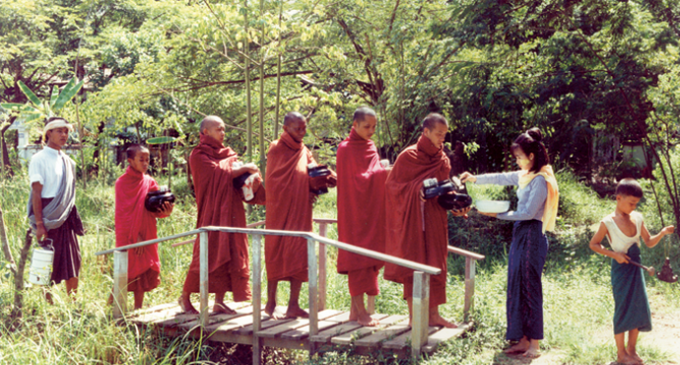A DAY IN THE LIFE IN A MYANMAR MONASTERY

Since Myanmar is predominantly Buddhist, a Myanmar monastery implies a Buddhist monastery. There is no village or town where there is no monastery. The residents of a monastery are called phongyis in Myanmar, bhikkhus in Pail. The collective term for four bhikkhus and more is the Samgha, the Order of bhikkhus. A bhukkhu is a follower of the Buddha who has renounced hearth and home and joined the Order in quest of Nibbana, the Eternal Peace where all human passions are stilled and the painful process of rebirth is put to a stop. The Buddha was the founder of the doctrine, called the Dhamma the practice of which leads one to the end of suffering that surrounds sentient existence. Buddhism is a free religion. No one–not even the Buddha himself–holds the key to a man’s salvation but himself. The Buddha was a human being, not God, nor a messenger of God. He showed to the world by his own example that salvation from the round of suffering through endless rebirths can be worked out by human effort without the assistance of any external agency. A bhikkhu is not a priest; he is not clothed with any religious authority, and does not minister to the old apart from giving discourses on the Dhamma when occasion demands.
The monastic system in the TheravaJda countries such as Myanmar, Sri Lanka and Thailand is one unbroken line dating back to the lifetime of its founder two and a half centuries ago in India. This tradition is kept so well, thanks to the stringent rules of conduct laid down by the Buddha and constituting one of the Three Baskets or Tipitaka, the complete set of canonical literature which forms the backbone of TheravaJda Buddhism. These Rules, called the Vinaya. consist of 227 items. They are not commandments. Rather, they are practical guides to good conduct befitting a bhikkhu, who by virtue of his morality, is deserving of worship by lay followers. But first of all let us see what qualifications are needed for a man to become a bhikku. Any human male who has attained the age of twenty, irrespective of caste, creed or social class, may join the Order, provided that he : (a) is free from certain diseases considered incurable in ancient days; (b) is free from debt and government service; (c) has parental consent; (d) possesses the eight items of bhikkhu requisites, namely, a set of three robes. (i.e. the lower loincloth, the upper robe and the double-robe as the top robe), an alms-bowl, cloth girdle, needle, razor, and water-strainer; (e) has a preceptor to sponsor him at the ordination. The ordination is a momentous occasion. It takes place in a consecrated hall. It is conducted strictly in accordance with the Vinaya rules. A minimum of five qualified samgha is needed to make a quorum.
Every Myanmr Buddhist boy at the age of about ten years or so enters the Order as a novice (saJmanera) and may stay there for a three month (rains-retreat) period or vasa. On completing twenty years of age, if he has the inclination, he proceeds to full bhikkhuhood by undergoing the higher ordination. A novice has only ten samanera precepts to observe, namely:
1. Abstaining from taking the life of sentient beings.
2. Abstaining from taking what is not given.
3. Abstaining from unchastity.
4. Abstaining from telling lies.
5. Abstaining from eating intoxicants.
6. Abstaining from eating after midday.
7. Abstaining from dancing, singing, playing music, and witnessing shows and entertainments.
8. Abstaining from wearing flowers and from using scents and beautifying cosmetics.
9. Abstaining from high and luxurious beds.
10. Abstaining from accepting gold and silver.
A bhikkhu has no worldy possessions other than the eight items of essential articles when he enters the homeless life. He is permitted by the Buddha to live in a monastery if there are donors to build one for him. In Mandalay. Pakokku and Yangon there are big monasteries that can house hundreds of bhikkhus, mostly undergoing scriptural learning. A bhikkhu’s primary duties are either to learn the scriptures or to practise the Buddha’s way of mental development that leads to NibbaJna, or if possible, both. Generally speaking, younger bhikkhus spend some years in learning the scriptures from elder ones. Let us take an example of a monastery in a big town where scriptural learning is the main occupation.
It is about 4 o’ clock in the morning. The time signal is heard from a mile or so; it is the beating of a thick hollowed piece of coconut stem or timber hung to a tree in the monastic compound, hence it is called on-moung, “gong-made-of-coconut-stem”. The beating starts very very slowly, the first stroke being followed only after a good interval by the second, to be succeeded by slightly quicker beats, gradually; then a succession of regular rhythmic beats neither slowly nor fast; then the beat slows down, gradually again, slower, slower, and slower still, and then with the final beat, the sound dies out and the fresh morning becomes still again. It is a very romantic sound, this sounding of the on-moung. It rouses up one from sleep by its differentiated rhythm in the quiet of the small hours when sleep is usually slight for all ages. It signals the rising time for the monastery as it also does for most of the lay folks around it – housewives generally–to cook rice for alms-offering.

Having risen, the whole monastery sit before the Buddha-image and say the morning prayers in unison. Buddhist prayers are not to be understood in the same light as prayers where a creator God is professed as religion. For although the language is that of prayers, a Buddhist is not praying to a supernatural Lord for favours, but he is saying his wishes aloud–mainly the avowed wish that one be free from the four miserable states (i.e the torturous realms of continuous physical suffering, the constantly-hungry-and-thirsty-existence as sub-human beings or petas, the animal world and the hapless sub-human beings called asurakaJya, (suffering pain alternated by short intervals of pleasure); from the three scourges (famine, pestilence and strife; from the eight inopportune circumstances (such as being born deaf and dumb or being born at a place where the Buddha’s Teaching is silent, etc); from the five enemies (i.e water, fire, rulers, thieves and malicious ones); and from the wrong states (i.e) the four miserable existences of apaJya, physical handicap, bad times, immoral livelihood); the five losses or deprivations (i.e . . . loss of kinsmen, wealth, health due to chronic disease, morality and right view); and then to attain to Path-Knowledge; Fruition-Knowledge and NibbaJna. In saying them the devotee understands that no one is going to answer his or her prayers but that one must strive for their realization oneself.
Those wishes make up a relatively short part of Buddhist prayers, for the main purpose is to worship, that is, to extol the Buddha, the Dhamma and the samgha. Concerning the Buddha, the great superhuman efforts of the Buddha-to-be in his various existences, over countless aeons, is always dwelt upon in deep devotion. This inspires one to nobler undertakings with greater zeal. Above all, remembering the Triple Gem is in itself a meritorious deed. Besides, the protective stanzas (parittas) uttered in unison has the blessing of warding off the evil that might threaten the environs. Morning prayers and worship may take half-an-hour or so. Then as dawn’s rosy fingers spread the eastern horizon the monastery becomes alive. The novices and a few young boys, lay pupils resident in the monaastery, carry water, prepare the shrine room or sweep the floors and the whole compound, under the supervision of a young bhikkhu. There is much activity but not much noise, for there is little conversation. The work is done efficiently and well.
Meanwhile some of the novices are laying the table for the early morning meal or breakfast which is a light meal of rice gruel or, in some monasteries, a humble meal of rice. The meal is prepared by some adult lay disciple residing at the monastery called the kappiya or attendant. The meal is over by about 7 o’clock.
Then the first session of scriptual classes for the day is conducted. The young students learn at the feet of an elder bhikkhu, grouped according to the levels of learning. The teachers in a big monastery are highly proficient in scriptures, having, generally, won recognition and public acclaim at the scriptural examinations that are held annually since the days of the Myanmar Kings.
At about eight-thirty or so, the short time-signal by the beat of the on-moung announces the hour for the daily alms-round. With the eldest monk leading the procession, lined up in order of seniority of bhikkhuhood–which is counted in vasas–the bhikkhus go out of the monastery; very neatly robed, with alms-bowl in both hands, eyes downcast, slowly they pass along the streets. From the houses along the street women or young children would come out with a little rice, a little curry or a little fruit, stand with both feet together, as the bhikkhus file past them, when each remove the cover of the alms-bowl wherein the food-offerings are reverently put in. Then the lid replaced, the bhkkhu moves on sedately. No acknowledgements is made. No conversation between donar and donee takes place. Yet in the heart of each party there is gladness in the knowledge of merit acquired: for the donar the merit of giving (daJna) as the foremost of all meritorious deeds paving the way to the Great Peace of NibbaJna; for the donee the merit of having earned well by virtuous conduct. Without the material support by way of daily alms-food, robes, monastic shelter and medicines, the Samgha cannot subsist. On the other hand, to a Buddhist who gives, the recipient of his charity is important from the point of view of acquiring merit, for the more worthy the donee is, the greater the merit. The Samgha on their part are thus bound by duty to make themselves worthy of the respect and sacrifice shown by their lay supporters.
Back at the monastery after an hour or so on the alms-round, the bhikkhus take bath and may have a short interval of private time before the day’s square meal is taken, which may be somewhere between 10:30 and 11 am. All the alms-food on the tables. The big theras or elders are assigned the best food by the bhkkhu who oversees the distribution. All have plenty to eat . The standard fare may be quite modest but nobody ever goes without sufficient food. For austerity is not the bhkkhu practice. Only when one is not tormented by hunger can one follow the path of salvation. But no food is taken after midday till the dawn of the nexy day. This is also in the interest of the noble practice. A filled stomach in the afternoon does not make for arduous learning of scriptures or for meditation.
But immediately after the day meal the bhikkhus remain in seclusion at their own assigned quarters within the monastery. The elder ones may rest a while for half an hour or so or meditate, while the younger ones may mend their robes or do some preparation for the studies.
It is about one o’ clock: the midday session of scriptural classes is resumed which lasts for an hour. Then there is a break for an hour during which students discuss and exchange in small informal groups what they have just learnt, which is a very practical and effective way of digesting and memorizing the lesson. Then the third session is resumed for an hour, followed by the discussions and exchanges between students, each in a group of one’s choice. This goes on up till about 5 pm.
Then follows the evening activity outdoors–perhaps more for exercise than for cleanliness– tidying up the premises, cleaning the latrines, filling water pots, etc. Incidentally, novices are also given the task of cleaning the latrines as punishment to atone for certain lapses in samanera discipline. Also there are the daily chores pertaining to the shrine-room where flower vases are rearranged with fresh flowers brought by lay devotees, little cups of water offered to the Buddha are renewed, lighting arrangements seen to (a more important function in monasteries). Elderly bhikkhus would walk up and down in meditation at the far end of the compound.
Sundown; as dusk falls (anywhere between 6 and 7 pm) the monastery congregate again for the evening prayers. But before saying the prayers, there goes on, routinely, the confession session. This is an acknowledgement made by a bhikkhu who has something on his conscience that he had, in the course of the day, or some time back in the past, the details having been blurred now, committed a breach of the Vinaya rules, with a repentant undertaking not to allow himself the same slip again. The fellow bhikkhu hears it, admonishes him to be watchful of his senses in future, and says saJdhu three times, congratulating on the straight conduct of the confessor. It must be noted here that not all errors are remediable. The four grave breaches of the rules of the Discipline result in the total fall from bhikkhudood. irremediable, an utter loss. Thirteen other rules involve formal Samgha proceedings for the reinstatements of the errant bhikkhu.
 Then follow the evening prayers and worship which may last up to one hour when more protective stanzas (parittas) are recited. After that one of novices declares to the congregation the date of the Buddha’s SaJsaJna (Teaching), i.e what date it is by popular reckoning or the current Myanmar calendar, and the year, month, the day of the month from the passing away of the Buddha (eg the year 1348 B.E is 2530 SaJsaJna Era, 1987 CE). And of course the prayers end, as usual by diffusing loving kindness and sharing merit to all sentient beings in the whole universe, on hearing which the devout says. “Well done” (SaJdhu) thrice and gain merit thereby. Merit or demerit is the measure of one’s volition: if an act is done by thought, word or deed, with pure or good volition it is called a meritorious act.
Then follow the evening prayers and worship which may last up to one hour when more protective stanzas (parittas) are recited. After that one of novices declares to the congregation the date of the Buddha’s SaJsaJna (Teaching), i.e what date it is by popular reckoning or the current Myanmar calendar, and the year, month, the day of the month from the passing away of the Buddha (eg the year 1348 B.E is 2530 SaJsaJna Era, 1987 CE). And of course the prayers end, as usual by diffusing loving kindness and sharing merit to all sentient beings in the whole universe, on hearing which the devout says. “Well done” (SaJdhu) thrice and gain merit thereby. Merit or demerit is the measure of one’s volition: if an act is done by thought, word or deed, with pure or good volition it is called a meritorious act.
It is now 7 pm: the novices are reciting the scriptures they are trying to memorize or to test their memory of what has been learnt. The bhikkhus now approach the abbot or the senior teacher to learn the Abhidamma. This is done without the aid of a book. In fact the night session is done in darkness without a light. The teacher lets the pupils recite what they have learnt, and asks questions to test their comprehension, for the Abhidhamma is abstruse. Then he goes on with new lessons which cover the Outline or MaJtika. After this class is over, there is a break of about half an hour or so and then another class begins in the same manner, this time it may be Yamaka.
The Abhidhamma is the Ultimate Dhamma. It is Dhamma with reference to no person whereas the Suttanta pitaka or the discourses were the Buddha’s dialogues to various person on various accasions, and the Vinaya pitaka is the disciplinary rules prescribed by the Buddha with a view to the prolonged existence of the Samgha and hence the perpetuotian of his Teaching. A good teacher in the Abhidhamma is indeed a boon to the student. These night sessions are therefore an invaluable tradition of Myanmar bhikkhuhood for the propagation of the Abhidhamma.
Thus the hours go by and it is already 10 o’clock. All lights are out. It is time to keep silent. The whole monastery takes a well-earned rest for the day. The more serious bhikkhus go into meditation in their own quarters. It should be remembered that the way to Nibbaba comprises in achieving supreme morality, supreme concentration of mind and supreme knowledge. Whereas bed-time it a time for complete silence, all the other hours of the whole day are also remarkably without hubbub and hurry, considering the large number of residents at the monastery and the packed programme they live by.
To a lay person who is unfamiliar with the Vinaya this observance of silence may seem somewhat strange. But the Vinaya is a wonderful set of rules for upholding practical discipline for the Order. They are wonderful because they prohibit all conceivable acts by a bhikkhu in thought, word or deed that can cause mental or physical pain to his fellow bhikkhus, that may incur displeasure by the laity, and above all, that will put him off the course of the right path. The Buddha’s constant exhortation to bhikkhus is reduced into just one stanza as follows:
“To refrain from all evil,
To do what is good,
To purify the mind.
This is the teaching of the Buddhas”.
Besides, there are other regulations that are more in the nature of obligations than rules such as service to one’s teachers, proper care and upkeep of the monastic permises, etc. There are meticulous details concerning how to robe oneself, how to eat (table manners); how to receive alms-food, how to sit or go about, and even the proper ways to answer the call of nature! All of those can be understood when one remembers what a bhikkhu is required to exercise in all his actions. Restraint of the senses is the lifeblood of bhikkhuhood. He eats not to satisfy his palate, but to keep himself alive so that he can live the noble life of purity. He wears the yellow robes not from vanity, but from decency. In short, he lives a most humble life, always remembering that all things, including himself, are decaying every moment, that they are impermanent (anicca), and being impermanent, they are not to be cherished, that they are fraught with suffering (dukkha), and as such do not obey any one’s will – not a self in truth and reality (anatta), but a compounded thing of just mind and matter.  No wonder then that the Samgha in Myanmar command the greatest reverence and admira-tion by the vast majority of the people. Among TheravaJda lay devotees, bhikkhuhood is the ideal to which they aspire. That is why many men don the yellow robe on a temporary basis for a three- month rains-retreat period or less, depending on personal circumstances. The object is to have a better appreciation of the noble practice of purity and also to accumulate merit, so that they may, in some future existence, become lifelong bhikkhus, putting behind them everything that is called good in this world, and standing on that sounder footing, work out for release from the wheel of rebirth.
No wonder then that the Samgha in Myanmar command the greatest reverence and admira-tion by the vast majority of the people. Among TheravaJda lay devotees, bhikkhuhood is the ideal to which they aspire. That is why many men don the yellow robe on a temporary basis for a three- month rains-retreat period or less, depending on personal circumstances. The object is to have a better appreciation of the noble practice of purity and also to accumulate merit, so that they may, in some future existence, become lifelong bhikkhus, putting behind them everything that is called good in this world, and standing on that sounder footing, work out for release from the wheel of rebirth.
U Tin U (Myaung)
./wp-content/uploads/2018/10/Emirate-Online-TDY.png)
















There are no comments at the moment, do you want to add one?
Write a comment